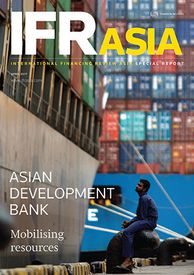Learn before teaching
ADB President Takehiko Nakao explains how the bank can use its 50 years of experience to meet Asia’s needs in a changing landscape for multilateral lenders.

Yokohama is an apt setting for the Asian Development Bank’s 50th anniversary meeting. The Japanese port city was one of the earliest to open to international trade, and one of the first beneficiaries of infrastructure financing that combined public and private resources at home and overseas. Japan’s first railway, a 29km track connecting Yokohama with Tokyo in 1872, was funded in part through bonds sold in the London market. Some 145 years later, the idea of mobilising international finance for Asian infrastructure remains as relevant today...Read more
To purchase printed copies or a PDF of this report, please email leonie.welss@lseg.com and shahid.hamid@lseg.com
ADB President Takehiko Nakao explains how the bank can use its 50 years of experience to meet Asia’s needs in a changing landscape for multilateral lenders.
The ADB’s funding team is well on the way to its busiest year in the capital markets. The bank expects to issue a total of US$25bn–$30bn in 2017, up from US$20.6bn last year. The jump is down to last year’s balance sheet restructuring, which combined the concessional resources of the Asian Development Fund with the bank’s ordinary capital resources. “There is some refinancing and liability management to do around the ADF resources, which are mainly denominated in SDR,” said ADB Treasurer Pierre van Peteghem. “Yes, there has been a big jump this...
For all the hype around the arrival of new multilateral lenders, concessional funding for Asian development is running scarce. Slow economic growth in much of the developed world has eaten into governments’ discretionary funding, and the migrant crisis in Europe has diverted some commitments closer to home. Asia’s growing prosperity is also leading many donors to prefer Africa and other regions where they feel their aid dollars can have more of an impact. These pressures, coupled with Asia’s continued need to lift 330 million people above the...
Efforts to connect institutional investors with greenfield infrastructure projects have so far yielded few results, but the ADB and others are banking on new schemes to help share the burden.
Socially responsible investment is catching on in Asia’s capital markets, opening new opportunities for global and local companies to broaden their funding sources. Green bonds have caught on fast in China and India, where public and private sector financiers have responded to government initiatives to tackle pollution and climate change. As well as banks refinancing their climate-aligned assets – the main source of Green bonds globally – corporate issuers in China have sold Green bonds for environmentally friendly cars, buildings, renewable...
Asia’s growing pool of homegrown capital is taking on new significance at a time when policy uncertainty looms over global money flows.
Asia has benefited from a relatively benign global backdrop in recent years, and is on track to grow at close to 6% again in 2017. Global risks, however, are rising after the UK’s decision to exit the European Union and the arrival of a new US administration.
Fears of a hard landing for China’s economy are off the table after the latest official GDP data pointed to a 6.9% expansion. But are investors right to ignore the risks?
(Reuters) China will gather its friends and allies together for its biggest diplomatic event of the year in May, a summit on its New Silk Road plan, with most Asian leaders due to attend but only one from a G7 nation, the Italian prime minister. President Xi Jinping has championed what China formally calls the “One Belt, One Road”, or OBOR, initiative to build a new Silk Road linking Asia, Africa and Europe, a landmark programme to invest billions of dollars in infrastructure projects including railways, ports and power grids. China has...
A weak banking sector and a hangover of failed infrastructure projects have challenged Narendra Modi’s bid to revive capital expenditure, but there are signs that the capital markets are helping revive the investment cycle.
Few Asian borrowers have been able to take advantage of cheap yen funding following Japan’s move into negative interest rates last year, but the market is opening up as Japanese institutions look for ways to boost their returns.